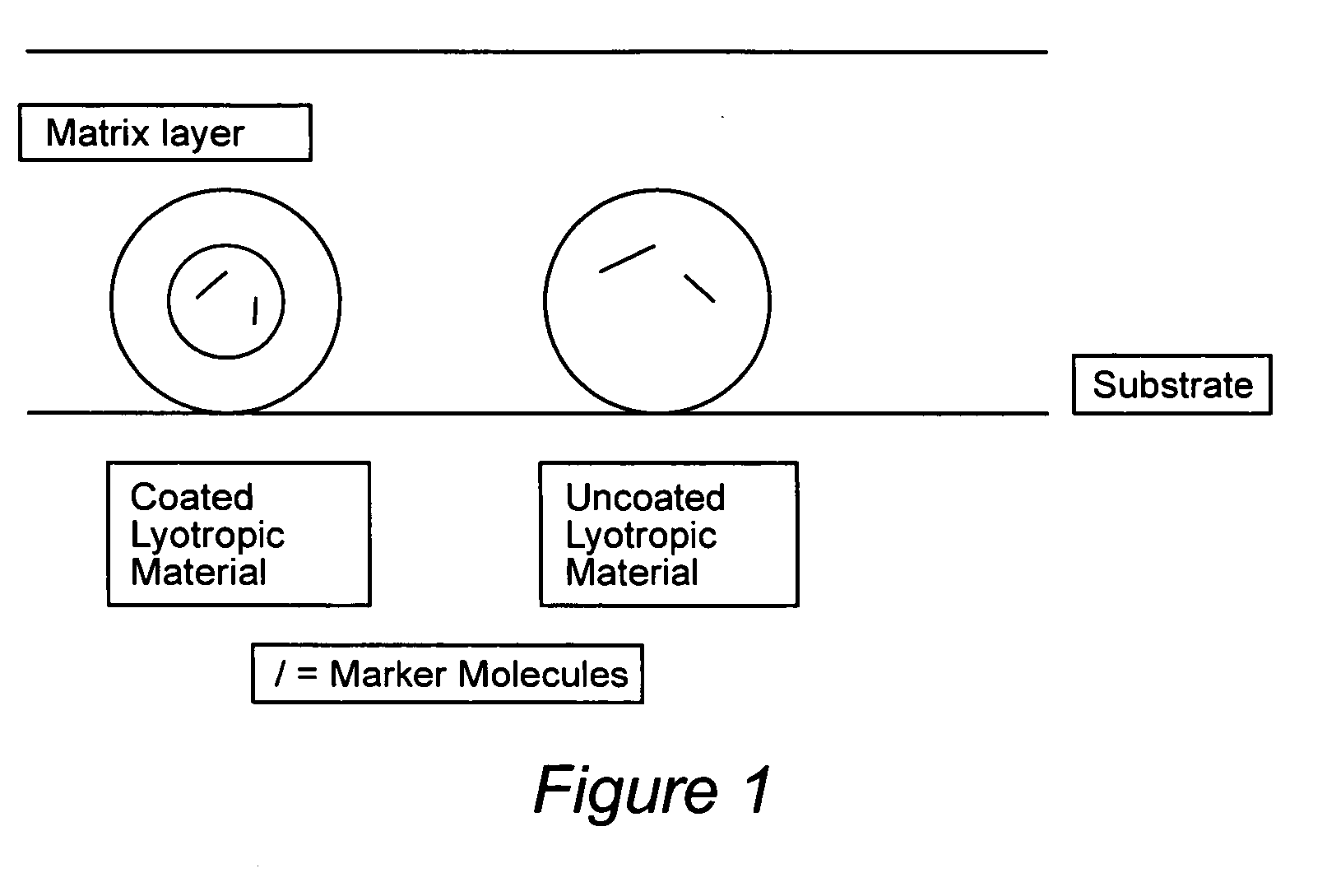Compositions for binding to assay substrata and methods of using
a technology of assay substrata and compositions, applied in the direction of material analysis, biological material analysis, instruments, etc., can solve the problems of increasing signal:noise ratio, substantially or even dramatically reducing the run-to-run variability of laser-desorption mass spec measurements, etc., to enhance surface binding of molecules and enhance matrix deposition
- Summary
- Abstract
- Description
- Claims
- Application Information
AI Technical Summary
Benefits of technology
Problems solved by technology
Method used
Image
Examples
example 1
[0131] A reversed cubic phase containing the protein insulin was prepared by first dissolving 0.111 grams of egg yolk ovomucoids (Belovo SA, Inc, Belgium) in 2.112 gm of a 20 mM sodium acetate, 0.5% sodium chloride, pH 4 buffer solution; the latter prepared by dissolving 0.272 gm of sodium acetate (Spectrum Chemical, Gardena, Calif.) and 0.500 gm of sodium chloride (EM Science, Gibbstown, N.J.) in 100 mL of distilled water and adjusting the pH to 4 with 1M hydrochloric acid (Sigma Chemical Company, St. Louis, Mo.). Next, 0.040 gm insulin from bovine pancreas (Sigma Chemical Company, St. Louis, Mo.) was dissolved in the buffer solution, and 0.004 gm phenol (Fisher Scientific, Fair Lawn, N.J.) added. Finally, 3.251 gm linalool (Aldrich Chemical Company, Milwaukee, Wis.), and 3.282 gm of Pluronic P123 (BASF, Mount Olive, N.J.) were added. After thorough mixing the material was optically isotropic and of high viscosity. Of this, 8.384 gm of cubic phase was combined in a 50 mL beaker wit...
example 2
[0145] Doubly-coated microparticle dispersions loaded with the fluorescent dye Rhodamine B base were prepared using the same procedure as in Example 1, then tested for binding to Ciphergen SELDI chips. In each case an aliquot of the dispersion was placed on one SELDI chip spot, incubated for about 15 minutes, and then washed. Using a Reichert-Jung Polyvar fluorescence microscope, the fluorescence intensity was recorded as an indicator of particle binding. Four types of Ciphergen SELDI chips were tested: NP20-8, CM10-8, H50-8, and Q-10. Each dispersion was diluted 1 to 10 with Krebbs Ringer buffer (pH 7.4, 4% albumin). Samples were labelled “KE”, “E100”, “HEX”, and “MYR” as follows, with the first and second coatings indicated: [0146] KE) Zinc-NAT / K-Emplex (sodium stearoyl lactylate) [0147] E100) Zinc-NAT / Eudragit E100 [0148] HEX) Zinc-NAT / hexadecyltrimethylammonium bromide [0149] MYR) Zinc-NAT / myristyltrimethylammonium bromide
The results were as follows: [0150] Q-10 chip: KE and ...
example 3
[0155] An L2 phase containing the anesthetic propofol was first prepared in a 100 mL test tube by mixing 0.302 grams of propofol (Albemarle Corporation, Baton Rouge, La.), 0.272 gm of vitamin E (Archer Daniels Midland Co., Decatur Ill.), and 1.653 gm of Pluronic L122 (Ethox Chemicals, Greenville, S.C.). Next, 0.162 gm of the anionic surfactant sodium deoxycholate (Aldrich Chemical Company, Milwaukee, Wis.) and 0.487 gm of glycine (Spectrum Chemical Company, Gardena, Calif.) were dissolved in 29.352 gm of distilled water. Then, 27.797 gm of the surfactant solution was added to the 100 mL test tube containing the propofol L2 phase. Upon contact with water, a reversed cubic phase was formed and subsequently dispersed using a homogenizer (Brinkmann Polytron PT 3000) at 29 k rpm for 10 minutes. The dispersion was filtered using a 0.22 μm PVDF syringe filter (Millipore, Ireland). Observation in a Reichert-Jung Polyvar microscope operating in differential interference contrast (DIC) mode d...
PUM
| Property | Measurement | Unit |
|---|---|---|
| diameter | aaaaa | aaaaa |
| unit cell size | aaaaa | aaaaa |
| temperature | aaaaa | aaaaa |
Abstract
Description
Claims
Application Information
 Login to View More
Login to View More - R&D
- Intellectual Property
- Life Sciences
- Materials
- Tech Scout
- Unparalleled Data Quality
- Higher Quality Content
- 60% Fewer Hallucinations
Browse by: Latest US Patents, China's latest patents, Technical Efficacy Thesaurus, Application Domain, Technology Topic, Popular Technical Reports.
© 2025 PatSnap. All rights reserved.Legal|Privacy policy|Modern Slavery Act Transparency Statement|Sitemap|About US| Contact US: help@patsnap.com



